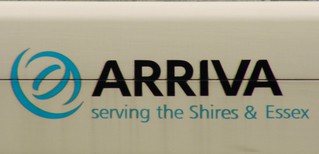 |
| First. Pretty meaningless really. You knew where you were with Northampton Transport. |
I have recently been re-reading my copy of Ian Allan Publishing's Buses in Britain, published in 1995, and it is saddening to see how many famous names and colourful liveries have disappeared over the last twenty years, not because they have ceased trading but because their parent groups have adopted corporate liveries and new names. In those days, only Stagecoach had such a livery and still retained the traditional company names as supplementary branding, but nowadays the old names and their sometimes long and distinguished histories have been wiped out in favour of generic 'straplines' such as 'Arriva serving Somewhere or Other' and 'Stagecoach in Your Town'. More recently, doubtless to reduce costs and ease transfers between fleets, even these have been eliminated so only the group name is now displayed, and one subsidiary's buses really are indistinguishable from another's.
 |
| A generic Arriva bus with no local identity. Could be anywhere. |
In my local area, the major operators were traditionally MK Metro, Luton & District Transport, United Counties and Northampton Transport. In the case of the latter two, they had been in existence since the 1920s and had become familiar features of the local landscape and vocabulary. The former pair dated back only to 1986 when they were created from parts of United Counties, but maintained a distinctive local identity with the names of the areas they served very prominent in their images. Alas, all are now gone: MK Metro and Luton & District are now part of 'Arriva serving the Shires & Essex', United Counties was swallowed up by Stagecoach Midlands and Northampton Transport was run down and closed altogether by First, but not before losing its identity. Certainly in Northampton and Milton Keynes, the decline in standards has been very noticeable since the big groups took over and these once-proud operators became shadows of their former selves, with elderly, unreliable and tatty vehicles and constant service cuts in a desperate attempt to make enough money to please the group management and shareholders.
 |
| Is knowing their buses also serve Essex really relevant to the people of Aylesbury. many miles away? |
Although I am too young to have been there, I imagine the enthusiast community of the 1970s had similar feelings towards the National Bus Company and its corporate image. However, the modern situation is arguably worse, as although the NBC foisted its Poppy Red and Leaf Green liveries on its subsidiaries, at least they were allowed to retain their names and some individuality was permitted so local pride still counted for something. Things aren't helped by none of the big groups' current liveries being particularly attractive in my opinion: Arriva's cow horns, Stagecoach's swoops and First's willow leaves all include odd shapes and colours that don't always suit the vehicle and seem to be applied in the same manner to everything with no consideration of how well they sit with the lines of the body.
 |
| Boxy bus, curvy livery. That just doesn't look right. |
One important disadvantage of a corporate livery that never seems to be mentioned is that, because the buses look the same everywhere, the majority of passengers don't see the individual operating companies but consider the entire group to be a single entity, and this is not necessarily a good thing. As an example, if you had received bad service from your local Arriva subsidiary and then saw identical Arriva buses elsewhere, your preconceptions of poor service would automatically attach themselves to these buses, even though they are actually operated by a separate company within the group. If group members had their own distinct identities such preconceptions would not occur and passengers would be far more open minded about travelling by bus in new areas.
 |
| One of the few remaining independent major operators. It's obviously a bus and obviously from Cardiff. Does what it says on the tin and doesn't look like the buses everywhere else. |
The Go-Ahead group seem to have the right idea by allowing each subsidiary to keep its identity and develop its own livery and branding while taking advantage of the power of a large group, but have perhaps gone too far in the north-east by adopting a completely different livery for each route, which creates a very disjointed looking operation. As conditions worsen for the remaining operators outside of the big groups, it is inevitable that even more consolidation will take place and the corporate blandness will spread still further and wipe out what little individuality remains. While all of this contributes to my waning interest in real buses, I take solace in the ever-growing ranks of model fleet operators who show a great deal of imagination and are free to come up with a whole range of diverse and colourful liveries, a fitting antidote to the boring uniformity of the real world. To paraphrase The League of Gentlemen, whatever happened to local buses for local people?
VISIT US
ReplyDelete